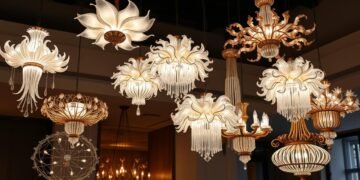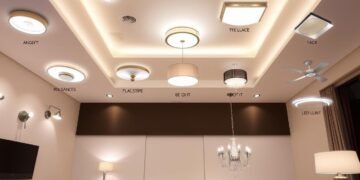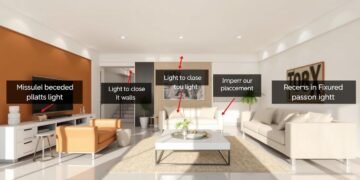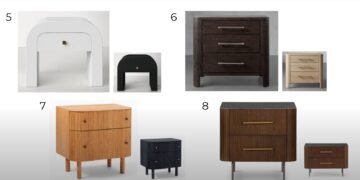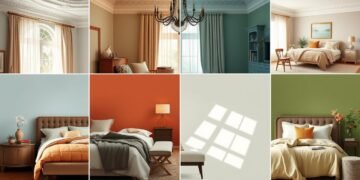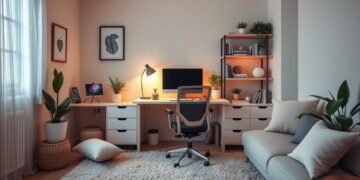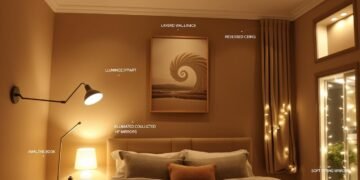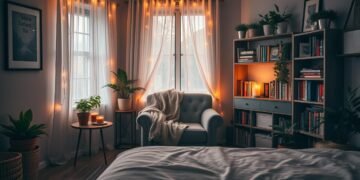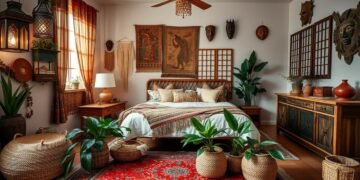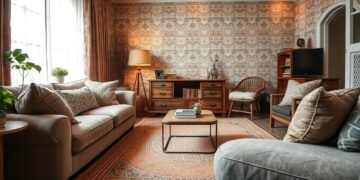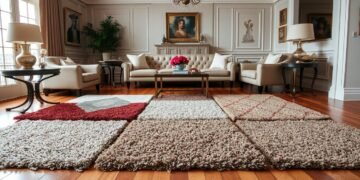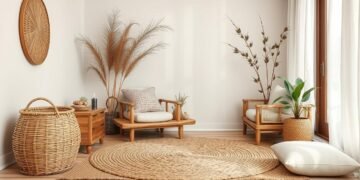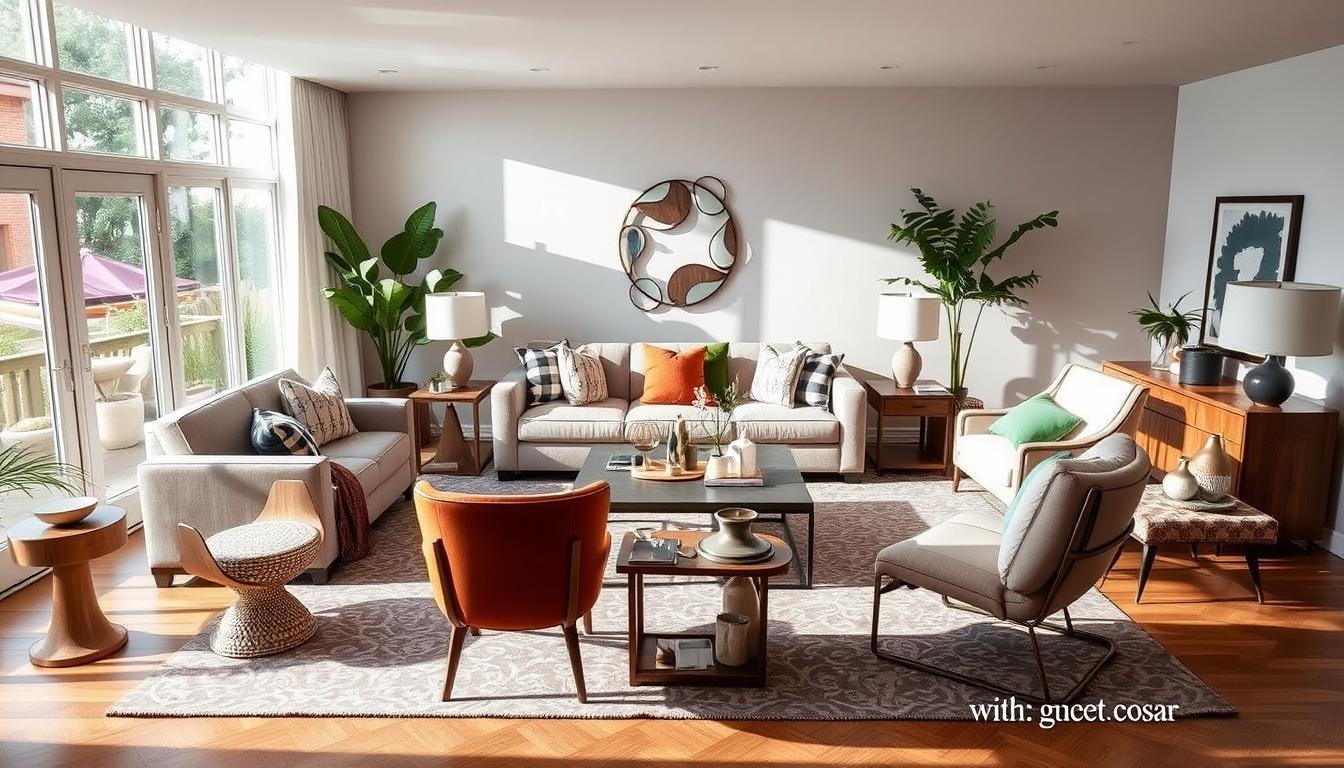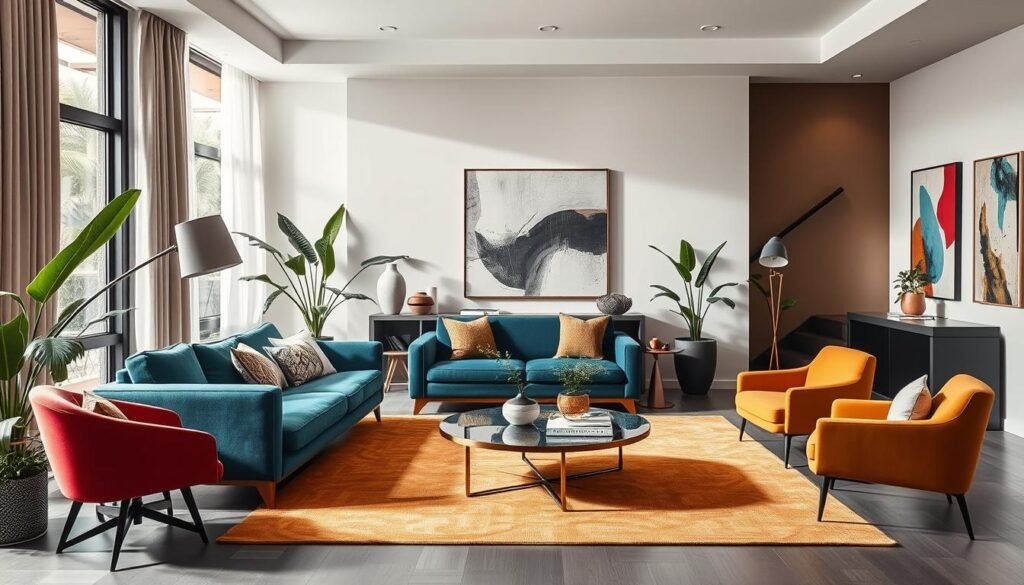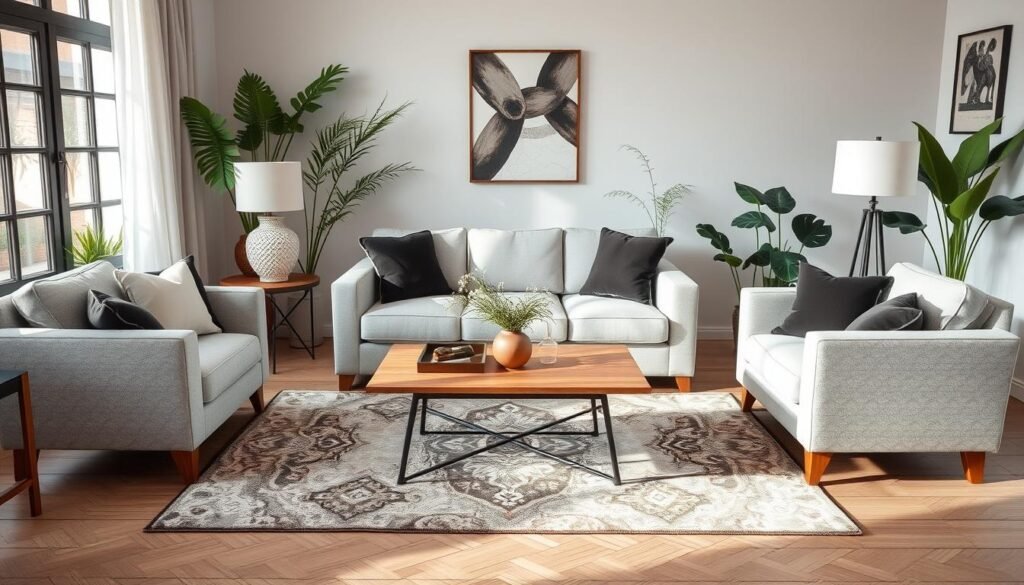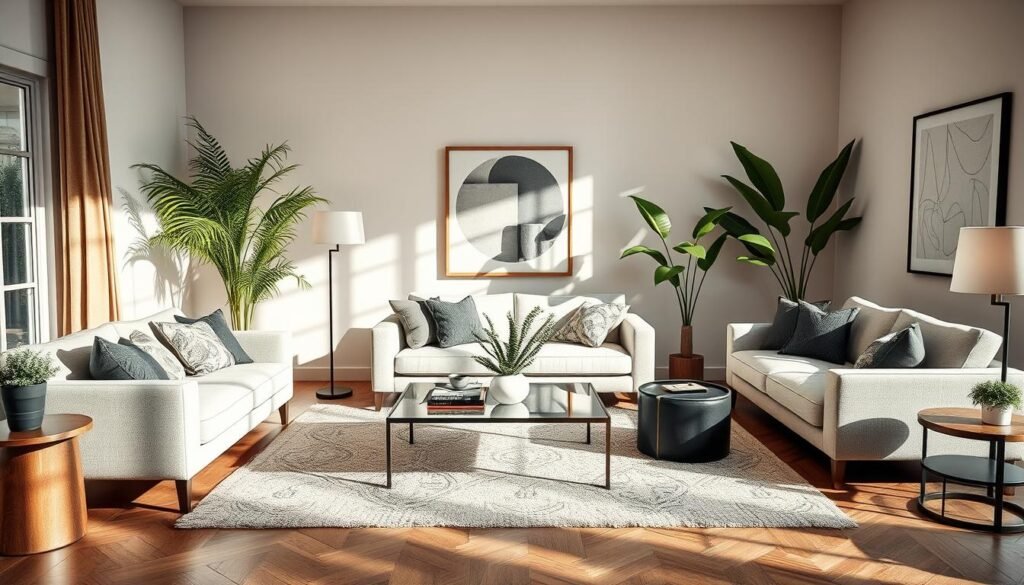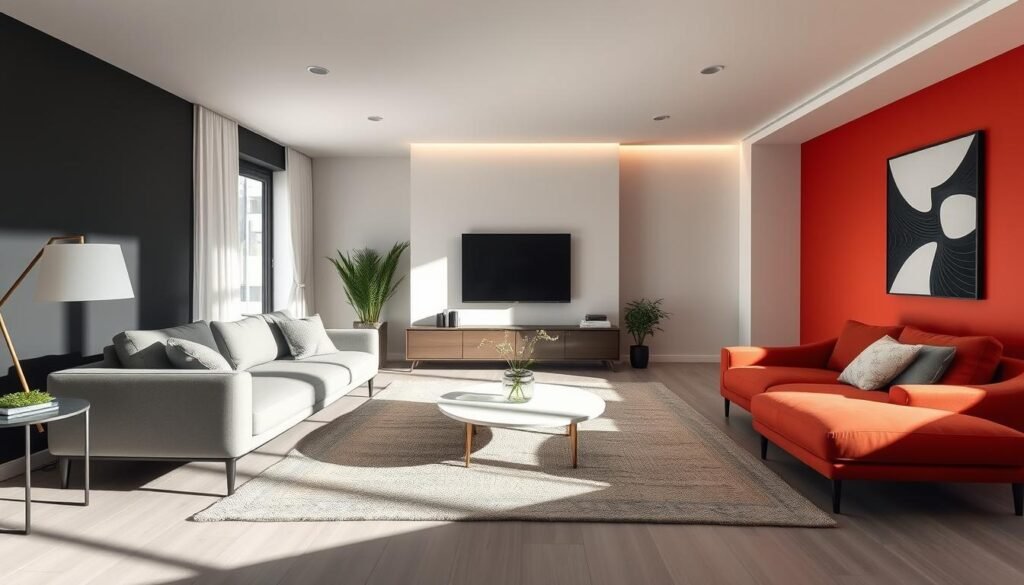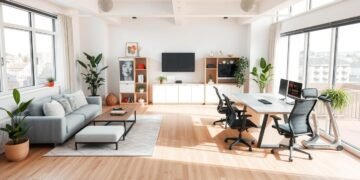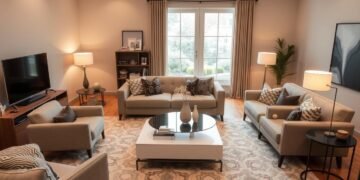Finding the right mix of symmetry and asymmetry in your furniture layout is a delicate task. It can make any room look amazing. Whether you want a formal look or something more casual, knowing how to balance is essential1.
Symmetry brings a sense of order and elegance to a room2. Asymmetry, on the other hand, adds a playful touch, making a space feel cozy and welcoming1. The goal is to mix these two styles well, creating a space that looks great and feels right.
Table of Contents
- 1 Understanding Balance in Interior Design
- 1.1 The Psychology of Balanced Spaces
- 1.2 Visual Weight Distribution
- 1.3 Relatedarticles
- 1.4 5 Effective Layout Strategies for Multi-Purpose Rooms & Shared Spaces
- 1.5 6 Virtual Tools & Apps to Perfect Your Layout Before You Buy
- 1.6 7 Common Furniture Arrangement Mistakes and How to Avoid Them
- 1.7 Creating Harmony Through Balance
- 2 Creating a Strong Foundation with Traditional Symmetry
- 3 Breaking Rules with Modern Asymmetry
- 4 Symmetry vs. Asymmetry in Furniture Layout
- 5 The Art of Visual Weight Distribution
- 6 Playing with Height and Scale
- 7 Using Contrast and Negative Space
- 8 Maintaining Flow and Functionality
- 9 Color and Texture in Balanced Design
- 10 Conclusion
- 11 FAQ
- 11.1 What is the difference between symmetrical and asymmetrical balance in interior design?
- 11.2 How can designers use a combination of symmetrical and asymmetrical elements in furniture layouts?
- 11.3 What is the importance of visual weight distribution in creating balanced interiors?
- 11.4 How do height and scale affect the balance of a room?
- 11.5 What role do contrast and negative space play in balanced design?
- 11.6 How can designers balance aesthetics and functionality when arranging furniture?
- 11.7 What is the importance of color and texture in creating balanced interiors?
- 11.8 How can homeowners and designers effectively balance symmetry and asymmetry in furniture layouts?
Key Takeaways
- Symmetry and asymmetry both have a place in interior design, each bringing its own charm.
- Blending these two can make your space look stunning and feel balanced.
- Using odd numbers and different shapes can help create an intentional asymmetry.
- Keeping colors and materials consistent can tie an asymmetrical layout together.
- Using furniture pieces that balance each other can add depth without mirroring.
Understanding Balance in Interior Design
Balance is key in interior design, making spaces both comfortable and beautiful. You might want visual interest through asymmetry or traditional symmetry. Knowing how to use balance is essential. It helps you create a strong focal point and achieve architectural harmony in your home.
The Psychology of Balanced Spaces
Symmetry uses the 1:1 ratio, also known as the Golden Ratio3. It brings order and stability, fitting classic and formal interiors. On the other hand, asymmetrical balance adds a dynamic feel, perfect for informal spaces3. Radial balance, seen in hotels and offices, creates stunning designs but is rare in homes3.
Visual Weight Distribution
Symmetry in design offers a balanced, harmonious look by mirroring one side of the room4. Minimalist spaces love symmetry for their clean look4. Patterns can also add symmetry, like repeating shapes in fabrics or on walls4. But too much symmetry can make a space feel stiff or too formal4.
Creating Harmony Through Balance
Asymmetry brings a fresh order to design, making layouts interesting without being predictable4. Asymmetrical balance uses different sizes or shapes around a focal point for balance4. Visual hierarchy is key, using bold art or eclectic decor to highlight focal points4.
Color balance in design uses harmony to create a visual hierarchy4. It’s important to balance bold colors with softer tones4. Patterns and textures help balance color, making focal points without overwhelming the space4. Too much intense color can make a room feel cramped or stressful4.
To add interest, layer furniture and accessories, and use textures for depth4. Symmetry is a basic feature humans find attractive in people or objects5. For asymmetrical balance, use odd numbers and find a focal point5.
Understanding balance in interior design helps create spaces that are both beautiful and comforting. Whether you like traditional symmetry or modern asymmetrical spaces, mastering balance unlocks your home’s design fullness.
Creating a Strong Foundation with Traditional Symmetry
Traditional symmetry is key to balanced design. It brings order and stability, making spaces look elegant and timeless67. By placing identical items on both sides of a central axis, it creates a stable and easy-to-understand environment8.
Mirror Image Arrangements
Mirror image arrangements are a classic example of symmetry. Think of matching nightstands on either side of a bed or identical sofas by a fireplace6. These setups appeal to those who love stability in their homes8.
Formal Room Layouts
Symmetry is also used in formal room layouts for elegance and structure. Furniture, artwork, and lighting are placed around a central point6. This is perfect for rooms with focal points like fireplaces or chandeliers8.
Benefits of Symmetrical Design
Symmetrical design is not just pretty; it’s practical too. It ensures furniture is placed right and there’s enough space for flow6. It also makes rooms look interesting and cohesive6.
While symmetry is strong, mixing it with asymmetry is key for dynamic interiors. The goal is to balance both for spaces that are both beautiful and functional78.
Breaking Rules with Modern Asymmetry
Interior design can be exciting when you break away from the usual and go for asymmetry. This style uses different objects and shapes on each side of a central point to look balanced. It makes your space look modern and interesting, adding a sense of movement9.
Asymmetry is all about being creative and flexible. It lets you think about how a room works, not just how it looks. This way, you can make spaces that feel welcoming and unique, unlike the strict layouts of old10.
To get an asymmetrical look right, focus on how things look together. Use different sizes, textures, and materials to make your space pop. Also, don’t forget the empty space around things to keep the balance10.
Start seeing your space as a canvas for creativity. Mix up the sizes and colors of your art and furniture. This way, you can create a space that’s truly yours, full of personality9.
The secret to great asymmetry is finding the right mix of looks and function. Let your creativity flow while keeping your space comfortable and practical. So, be bold and let modern asymmetry guide your design11.
Symmetry vs. Asymmetry in Furniture Layout
Interior designers often debate between symmetry and asymmetry in furniture placement. Symmetry brings order and formality, while asymmetry adds visual interest and flexibility12. The choice between these styles usually depends on personal taste, not strict rules12.
Traditional vs. Contemporary Approaches
Symmetry is a key part of traditional design, inspired by old architecture and art12. Modern design, on the other hand, favors the energy of asymmetry, breaking free from traditional balance12. Yet, both styles can create harmony when done thoughtfully.
Mixing Both Styles Effectively
Many designers mix symmetrical and asymmetrical elements for a balanced look13. For example, a symmetrical sofa can be paired with asymmetrical side tables or art for a harmonious mix13. This way, homeowners get the comfort of symmetry and the creativity of asymmetry.
Creating Dynamic Spaces
Finding the right mix of symmetry and asymmetry can change a room’s feel13. Symmetry is great for hiding strong features like fireplaces or big TVs13. Asymmetry, on the other hand, brings dynamism and intrigue, perfect for small spaces13.
The secret to great furniture layout is balancing symmetry and asymmetry based on the homeowner’s needs and style1213. By using both traditional and modern styles, designers can make spaces that are both functional and beautiful.
| Symmetry | Asymmetry |
|---|---|
| Provides a sense of order and formality | Offers more visual interest and flexibility |
| Rooted in traditional interior design | Embraced by modern and contemporary styles |
| Helpful for blending strong architectural features | Can create a more open and organized feel in small spaces |
“The key to a successful furniture layout is to find the right balance between symmetry and asymmetry, tailored to the specific needs and style preferences of the homeowner.”
The Art of Visual Weight Distribution
Creating balance in interior design is an art. Understanding visual weight distribution is key. It’s about arranging elements based on their heaviness or lightness. This makes your space look harmonious and striking14.
Big, dark, or complex items weigh more visually than small, light, or simple ones. Designers use this to balance rooms. They place heavy items with light ones or group light pieces against a heavy item14.
This method works for both symmetrical and asymmetrical layouts14. By thinking about the visual weight of your furniture and decor, you can improve your style. You’ll create a balanced space that draws the eye14.
Symmetrical layouts feel formal and ordered, while asymmetrical ones are dynamic and interesting15. The goal is to find a balance. Use contrasting elements to add depth and rhythm to your space15.
Scale, proportion, negative space, and balanced composition are vital for a captivating space15. Mastering visual weight distribution can make any space beautiful and harmonious14.
“The way to achieve balance is not by symmetry, but through a dynamic equilibrium of opposed forces.” – Jan Balet
Playing with Height and Scale
Creating visually appealing interiors involves using height and scale wisely. By mixing furniture, decor, and architectural elements, you can achieve balance and interest. This enhances your interior styling16.
Vertical Balance Techniques
It’s important to balance vertical elements in a room for a cohesive look. Use tall pieces like bookshelves, floor lamps, or statement artworks to anchor the space. This balances lower-profile furniture17.
This thoughtful arrangement of heights prevents the room from looking flat. It adds depth and interest.
Size Variation Strategies
Using different sizes adds depth and intrigue to your space. Mix large and small-scale furnishings for balance and proportion17. Pair a big sectional with small side tables, or a grand chandelier with a cozy dining table.
This mix of sizes prevents the space from feeling dull. It makes the environment visually dynamic.
Creating Visual Interest
Manipulating height and scale creates captivating spaces. Use asymmetrical elements like off-center lighting or uneven shelving to break symmetry18. This approach adds movement and intrigue, making your design stand out.
“The key to successful interior design is finding the perfect balance between symmetry and asymmetry, allowing each element to complement the other and create a harmonious whole.”
As you work on balancing height and scale, remember the importance of proportion, negative space, and functional layouts. These elements help create inviting and visually appealing interiors161718.
Using Contrast and Negative Space
Creating a beautiful interior space involves using contrast and negative space wisely. Contrast brings depth and interest, defining different areas in a room19. Asymmetrical spaces use contrast to create unique and intriguing environments19. Mixing different sizes and shapes of decorative items19 and combining big furniture with light pieces19 helps balance the look.
Negative space is also key in balanced design19. It lets the eye relax, avoiding clutter and focusing on design elements19. Using different colors and materials adds visual impact19. Arranging furniture and decor thoughtfully highlights certain areas in asymmetrical designs20.
Creating balance through contrast and negative space is a continuous process19. By mastering this, you can create a minimalist aesthetic that is both visually appealing and functional. It guides traffic flow and showcases the scale and proportion of your space.
“Asymmetry offers flexibility, innovation, and a fresh perspective in interior decoration.”20
| Symmetrical Design | Asymmetrical Design |
|---|---|
| Considered a time-honored and obvious way to achieve balance in a space19. | Gaining popularity in furniture layouts20. |
| Creates a more structured and formal environment19. | Introduces a dynamic and intriguing aesthetic20. |
| Relies on mirrored arrangements and formal room layouts19. | Utilizes contrast, variation, and unexpected arrangements for visual interest20. |
Maintaining Flow and Functionality
When designing your furniture layout, focus on flow and functionality21. Creating different zones in a room boosts organization, which is key in open-plan spaces21. Make sure furniture allows for easy movement to avoid a cramped feel21. It’s also important to balance the visual weight of furniture to prevent overcrowding.
Traffic Pattern Considerations
Think carefully about traffic patterns for a practical layout21. Using multi-functional furniture, like ottomans with storage, can save space in small rooms21. To make a small room look bigger, use vertical space, light-colored furniture, and mirrors.
Practical Layout Solutions
22 Asymmetrical design creates balance by unevenly distributing visual weight22. It brings visual interest, flexibility, and dynamic spaces22. Key principles include balance, focal points, and visual flow.
Balancing Form and Function
22 Whether to choose symmetry or asymmetry depends on personal taste and the room’s purpose21. Make sure your furniture layout can change with your needs21. By balancing looks with practicality, you’ll get spaces that are both beautiful and useful.
“Asymmetrical design enhances visual flow by guiding the eye naturally through the space.”22
22 Working with an interior designer can help with asymmetrical design22. They bring expertise to make your space both beautiful and functional. This way, you’ll have a living area that’s inviting and well-designed.
Color and Texture in Balanced Design
A well-balanced interior design is more than just symmetry and proportions. Color and texture also play a big role in making a space look good23.
Color can make objects in a room look heavier or lighter. Dark colors make things seem heavier, while light colors make them feel airy. Choosing the right colors can balance a room, even if it’s not perfectly symmetrical23.
Texture adds depth and interest to a room. Mixing different textures, like soft fabrics, wood, and metal, makes a space more interesting. This works well in both symmetrical and asymmetrical layouts, adding depth23.
The “Rule of Three” is a design trick for balance. Using odd numbers, like three or five, makes things look better and more balanced23.
While symmetry is often seen in formal settings, asymmetry can make a space feel more relaxed and creative23. But, asymmetry might not fit well in very formal or traditional rooms, where symmetry is preferred for its order23.
Designers often look to different cultures for inspiration on balance and harmony. For example, Japanese Wabi-Sabi values the beauty of imperfection and irregularity. In Feng Shui, asymmetry helps balance energy, allowing it to flow freely23.
To use asymmetry in your design, try using natural items and embracing imperfect shapes. Include irregular patterns and organic textures. Choose nature-inspired patterns and display authentic artwork. Mix bold and subtle art and hang it asymmetrically23.
Understanding color, texture, and asymmetry helps create balanced and beautiful spaces. These spaces reflect your style and meet your home’s needs232425.
Conclusion
Choosing between symmetry vs. asymmetry in furniture layout is a delicate art. It involves understanding visual weight, proportion, contrast, and function. Symmetrical furniture placement brings structure and formality. On the other hand, asymmetrical room arrangements add dynamism and interest.
The best interiors mix both, creating spaces that are both harmonious and visually appealing. This blend of approaches makes spaces that reflect personal style and meet practical needs.26
Symmetry can make small rooms look bigger by avoiding overcrowding. Mirrors can enhance this effect, making the space seem larger27. On the other hand, asymmetry in interior design brings creativity and spontaneity, adding visual excitement27.
Yet, it’s key to keep balance, even with varied elements, to prevent the space from feeling disjointed or cluttered27.
Whether aiming for formal vs. casual aesthetics, the best designs combine symmetry and asymmetry. This creates dynamic, harmonious, and functional living spaces. By mastering balanced interior design, anyone can turn any room into a stunning and livable space.

